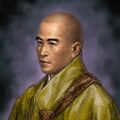Ikkō-ikki, literally "single-minded leagues", were mobs of peasant farmers, monks, Shinto priests and local nobles, who rose up against samurai rule in 15th to 16th century Japan. They followed the beliefs of the Jodo Shinshu (True Pure Land) sect of Buddhism which taught that all believers are equally saved by Amida Buddha's grace. They were organized to only a small degree; if any single person could be said to have had any influence over them it was Rennyo Honganji, the leader of the Jodo Shinshu Honganji sect at that time. Rennyo's attitude to the Ikkō-ikki was, however, highly ambivalent and pragmatic. Whilst he may have used the religious fervour of the Ikkō-ikki in the defence of his temple settlements, he was also careful to distance himself from the wider social rebellion of the Ikkō movement as a whole, and from offensive violence in particular.

a gruop of Ikkō - ikki, displaying a buddhist banner.
Sengoku Period[]
The Ikkō-ikki were, at first, disparate and disorganized followers of Rennyo's teachings. His missionary work, and his appointment to the position of abbot of Honganji, was in 1457, so perhaps it can be said that the Ikkō-ikki began then. In 1471, Rennyo was forced to flee Kyoto, and established a new Honganji branch temple in Yoshizaki, in Echizen Province; it was at this temple that he began to attract a significant following among peasants and farmers. 1488 brought the first violent uprising, the first major organized action on the part of the Ikkō-ikki. They overthrew the samurai rulers of Kaga Province, and took control of it for themselves; this represented the first time in Japanese history that a group of commoners ruled a province.
Rennyo was a pacifist, and taught pacifism as any other Buddhist clergyman would. He advocated self-defense only as a guard against the particularly tumultuous times in which he lived. Daimyo, samurai warlords, fought one another for territory nearly constantly, across the entire country. Rennyo thus saw to it that the temples of his sect were fortified and defended from attackers. Though it was his charismatic leadership and populist teachings that inspired the fervor which powered the Ikkō-ikki uprisings, he never advocated or supported them.
The uprisings continued nevertheless, past Rennyo's death in 1499, and the sub-sect of Jodo Shinshu that he had founded spread as well. They established themselves in fortresses at Ishiyama Honganji, just outside Osaka, and in Nagashima, on the borders of Owari and Ise Provinces, and in a series of temples of Mikawa Province as well.
Towards the end of the 16th century, however, their growing numbers and strength caught the attention and concern of the great samurai leaders of the time. Ieyasu Tokugawa worried that the monks of Mikawa would rise up and seize the province. In 1564, his forces, with the help of Jodo sect warrior monks, defeated the Ikkō-ikki of Mikawa in the Battle of Azukizaka.
The ikki attracted the ire of the likes of Ieyasu and Nobunaga Oda due to the economic and political threat they posed, more so than as a result of their military might. The Ishiyama Honganji and other strongholds of the ikki lay across major trade routes and occupied the same areas that Nobunaga saw as his primary territorial objectives. Nearly every road to the capital from this western part of the country was controlled by the ikki or their allies, and the populist roots of the ikki movement gave them significant economic power as well. Nobunaga in particular sought the destruction of the Ikkō-ikki for these reasons, and because they allied themselves with nearly every one of his major enemies or rivals. Yoshiaki Ashikaga was once strongly supported in his claim to become Shogun by Nobunaga, but turned to the ikki when their relationship soured. The ikki also had powerful allies in the Mouri, Azai, and Asakura clans.
The Ishiyama Hongan-ji and Nagashima fortresses were therefore besieged and destroyed by the forces of Nobunaga. After several failed attempts at seizing each emplacement, he eventually succeeded.
In the 1580s, the last of the Ikkō-ikki courted Hideyoshi Toyotomi, and fought alongside his forces against warrior monks of other sects.
Lifestyle[]
The Ikkō-ikki monks, due largely to their origins as countryside mobs, were quite varied in their armor and armament. Many wore the more traditional monk robes, with varying degrees and types of armor. Many wore various sorts of helmets, while many others opted for the straw hat and cloak of a peasant.
Weapons[]
Naginata remained very common, along with a variety of swords and daggers, and a limited number of arquebuses. Finally, while not truly armor nor armament, a very common item wielded by the mobs of Ikkō-ikki monk warriors was a banner with a Buddhist slogan written upon it.


